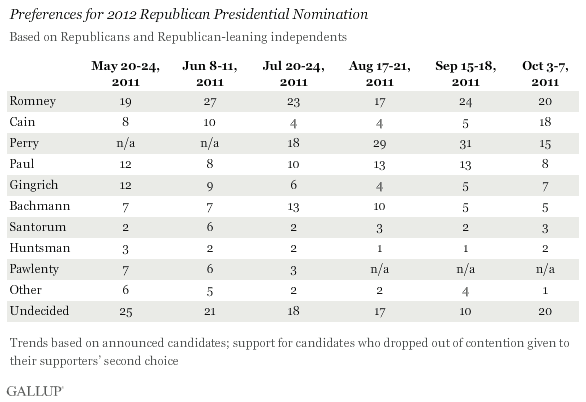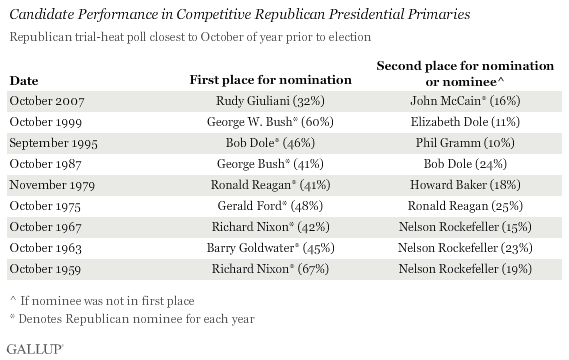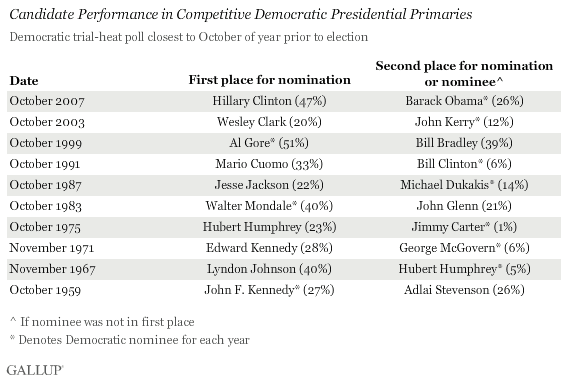PRINCETON, NJ -- Republicans' support for Herman Cain has surged to 18%, their support for Rick Perry has sagged to 15%, and their support for Mitt Romney remains relatively stable at 20%. However, Romney's support is matched by the 20% of Republicans who are unsure which candidate they will back for the Republican nomination in 2012.

Gallup's Oct. 3-7 update of Republicans' preferences for their party's 2012 presidential nominee shows that Romney since mid-September has regained a numerical lead over the rest of the field, mainly because Perry's support has dropped by half over the same period. At the same time, support for Cain has more than tripled, from 5% to 18%, creating a competitive three-way race for the nomination between Romney, Cain, and Perry -- all within five percentage points of each other. Prior to now, Gallup has had Romney out front, Perry out front, or a two-way battle between them.
Also of note in the new results are Ron Paul's return to single-digit support levels, and the failure of Michele Bachmann, Newt Gingrich, Rick Santorum, and Jon Huntsman to make significant gains.
Republicans Have Historically Nominated Early Front-Runners
Republicans' current lack of consensus about who should face President Barack Obama next fall is in stark contrast to Republican primary contests over the past half century in which, in all but one case, the eventual nominee was the runaway leader by this point in the campaign.
For instance, in early October 1999, George W. Bush led the Republican field, with 60% of Republicans preferring him for the 2000 nomination. Bob Dole led at a comparable point in 1995 with 46%, George H.W. Bush in 1987 with 41%, Ronald Reagan in 1979 with 41% (in a trial heat that did not include former President Gerald Ford), and so on back to Richard Nixon in 1959, when he led with 67%.
The exception occurred in 2007, when the eventual Republican nominee, John McCain, was drawing just 16% support in early October, putting him in third place behind Rudy Giuliani (32%) and Fred Thompson (20%) for the 2008 nomination.

Republicans in 2011 Are Following Democrats' Primary Pattern
Republican trial-heat trends show that there has been a strong front-runner by this point in the campaign -- three to four months before the first primaries are held. In contrast, the Democratic fields in past elections tended to be more competitive, and thus may provide a better point of comparison for interpreting today's fractured Republican field.
In the 10 presidential elections since 1960 that involved a competitive Democratic primary campaign, the Democrat with a significant lead in October of the year before the election won the nomination in only 2 cases: sitting Vice President Al Gore in 1999, with a 12-point lead over Bill Bradley, and former Vice President Walter Mondale in 1983, with a 19-point lead over John Glenn.
In the remaining eight elections, the eventual front-runner's position at this point was tied for first (John F. Kennedy in 1959), second (Barack Obama in 2007 and Michael Dukakis in 1987), third (Hubert Humphrey in 1967), fourth (John Kerry in 2003 and George McGovern in 1971), sixth (Bill Clinton in 1991), or ninth (Jimmy Carter in 1975).
In several cases (1991, 1971, and 1967), the Democrat leading at this point was someone who ultimately did not seek the nomination; however, in many cases (2007, 2003, 1991, 1987, 1975, 1971, and 1967), the eventual nominee still trailed one or more active candidates.

Bottom Line
Romney and Cain currently lead in Republicans' preferences nationally for the 2012 GOP presidential nomination. However, their 20% and 18% support levels, respectively, are well below where most previous Republican nominees stood in October of the year prior to the election.
Today's Republican lineup is more akin to the history of Democratic primary campaigns than Republican campaigns. And it may be instructive to note that the Democrats' eventual nominees often ranked second or lower at this stage leading up to the election year. Of course, the media, political climate, and political system are quite different today from decades past, so the opportunity for candidates with lower support to surge into the lead as a result of early primary (or state party convention or caucus) wins may not be as great as it once was.
In the meantime, Gallup is seeing plenty of surging and plunging of candidates as a result of the media exposure they are receiving from the Republican straw polls and debates. Given that, and the still-sizable percentage of Republicans who are undecided, history suggests the race may remain fluid for some time.
Survey Methods
Results are based on telephone interviews conducted as part of the Gallup Daily tracking survey Oct. 3-7, 2011, with a random sample of 1,064 Republicans and Republican-leaning independents, aged 18 and older, living in all 50 U.S. states and the District of Columbia, selected using random-digit-dial sampling.
For results based on the total sample of Republicans and Republican-leaning independents, one can say with 95% confidence that the maximum margin of sampling error is ±4 percentage points.
Interviews are conducted with respondents on landline telephones and cellular phones, with interviews conducted in Spanish for respondents who are primarily Spanish-speaking. Each sample includes a minimum quota of 400 cell phone respondents and 600 landline respondents per 1,000 national adults, with additional minimum quotas among landline respondents by region. Landline telephone numbers are chosen at random among listed telephone numbers. Cell phone numbers are selected using random-digit-dial methods. Landline respondents are chosen at random within each household on the basis of which member had the most recent birthday.
Samples are weighted by gender, age, race, Hispanic ethnicity, education, region, adults in the household, and phone status (cell phone only/landline only/both, cell phone mostly, and having an unlisted landline number). Demographic weighting targets are based on the March 2010 Current Population Survey figures for the aged 18 and older non-institutionalized population living in U.S. telephone households. All reported margins of sampling error include the computed design effects for weighting and sample design.
In addition to sampling error, question wording and practical difficulties in conducting surveys can introduce error or bias into the findings of public opinion polls.
View methodology, full question results, and trend data.
For more details on Gallup's polling methodology, visit www.gallup.com.
